Japanese
English
- 有料閲覧
- Abstract 文献概要
- 1ページ目 Look Inside
はじめに
今日,デュシェヌ(Duchenne)型筋ジストロフィー(DMD)と呼ばれる疾病の最初の記載はおそらくMeryon(1852)にさかのぼるといわれる。彼は10人の子供をもつ一家で,男児4人すべてが小児期より発症した筋萎縮症を報告した。1例の剖検では,脊髄や神経に異常はなく,骨格筋のみに高度の変化が観察された1)。
Duchenne(1868)は同様な15症例を報告したが,これらはすべて孤発型であったという。臨床症状や経過の記載があり,下腿腓腹部の肥大に注目してpseudohypertrophic muscular paralysisと病名を付した2)。Gowers(1879)は同一疾病について詳細な臨床的記載を行ない,幼少時発症,進行性経過,男児にのみ発病する事実,両親は正常であることなど重要な指摘を行なっている3)。しかしその後の約半世紀は本症の知見にさしたる進展もみられていない。1950年代に入り,遺伝学的知識が導入され筋ジストロフィー分類が再検討されたり。Waltonらは仮性肥大を伴う小児重症筋ジストロフィーはほとんど常にX-linked recessive(性染色体劣性)の遺伝形式をとることを明らかにした4)。
DMD is the most severe form of X-linked muscular dystrophy. Summarizing clinical genetics of DMD, two problems, i.e., heterogeneity of DMD and occurrence of female patients with DMD. were discussed.
The principle of RFLP (restriction fragment length polymorphism) has been applied to the linkage study of DMD. The gene locus of DMD wat assigned to Xp21 region. Studies on female patients with DMD, who exhibited balanced X-autosonic chromosomal translocation, supported the conclusion. Currently, two probes, λRC8 and Ll. 28, are reported to flank thet DMD locus. These probes, however, are about 15 CM from DMD site.

Copyright © 1985, Igaku-Shoin Ltd. All rights reserved.


